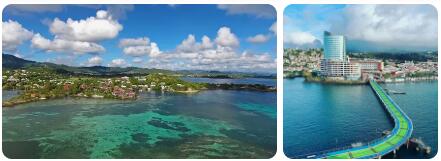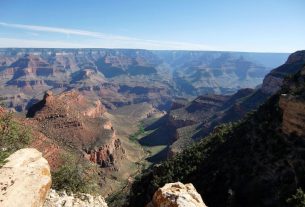The original residents called their island Madinina, “Island of Flowers” and even Columbus, who was known as a rather taciturn contemporary, became poetic when he saw the island: “… the most fertile, sweetest, mildest and most magical spot on earth…”
Martinique is covered by dense vegetation, especially the north is covered with rich rainforest, which also allows the most exotic flowers to grow right on the roadside.
Otherwise, the island does not leave any Caribbean dreams open, bays with white beaches line the coast, volcanoes rise inland, numerous former sugar cane and rum plantations invite you to visit the French-colonial atmosphere that is still there and is wonderful Gardens and parks invite you to take a stroll.
The French mother country, the descendants of the black slaves with their African roots and also the numerous other immigrants have left behind a colorful alliance of colors, music, excellent food and a special culture.
| Name of the country | Martinique department (France) |
| Form of government | French overseas department |
| Geographical location | around 61 ° west longitudearound 14 ° north latitude |
| National anthem | Marseillaise |
| Population | 375,000 (Credit: Countryaah: Martinique Facts) |
| Ethnicities | 90% black and mixed race5% whiteness
3% Indian (mainly Tamils) 2% others |
| Religions | 85% of the population is Roman Catholic11% Protestant (mainly Adventists)
the rest Islamic and Hindu |
| Languages | French and Creole |
| Capital | Fort-de-France |
| Surface | 1,128 km² |
| Highest mountain | Montagne Pelée with a height of 1,397 m |
| Longest river | Rivière la Lézarde with a length of 30 km |
| Largest lake | Lac de la Manzo (artificial reservoir) |
| International license plate | F. |
| National currency | Euro |
| Time difference to CET | – 5 h |
| International phone code | 00596-596 |
| Mains voltage, frequency | 220 volts, 50 hertz |
| Internet TLD (Top Level Domain) | .mq |
History of Martinique
Until around the year 1000
4,000 – 6,000 years ago, the Indians who were settled in South America, especially from today’s Venezuela, managed to colonize some Caribbean islands. Bone finds and grave goods from the Ciboney, which began around 2000 BC. BC populated almost all the islands of the Antilles, show a close relationship with the finds that have been made in Venezuela. The Ciboney were followed between the first and eleventh centuries by the Arawaks, who also visited the entire Antilles region, they brought agriculture (especially cassava) with them. The Arawken were peace-loving and consisted of several tribes, such as the Taino or the Igneri.
From the year 1000 to the 17th century
According to Abbreviationfinder website, the Arawaks followed the Caribs, they came from the north coast of South America (Surinam, Guayana) and landed in the Lesser Antilles around the 14th century, where they attacked the Arawaks, enslaved their husbands and married their wives. The Arawaks had nothing to oppose the Caribs with their weapons, which were highly developed for that time, so they had to allow themselves to be pushed to the north.
At the time of Columbus, only Trinidad and the Virgin Islands were still inhabited by the Arawaks. Columbus himself discovered the Antilles in 1492, since he suspected to have landed in India, he called the islands the West Indies. Martinique was only discovered on Columbus’ 4th voyage from 1502-1504. The French were able to gain a foothold in the Caribbean in quick succession in the 17th century, and landed in Martinique in 1635.
The exploitation of the islands by the Europeans began as soon as they were discovered. Since the islands could not boast rich natural resources, the Caribs were enslaved and shipped to Spain, most of them died within 5 years due to the climate change and the strenuous work, then the slave shipping was stopped, but slavery was maintained on the islands.
After most of the indigenous people on the island had also been massacred, the first black slaves were transported to the Antilles from 1524 to work on the plantations of the immigrant Europeans. After the tobacco market collapsed, the colonists switched to sugar cane and later rum as an export item.
The working and living conditions of the black slaves were so cruel that even French colonial officials Louis XV. (1710-1774) asked for a code to remedy the worst of grievances. This “code noir” gave the situation of those affected a legitimate name, but did not really improve the situation of the disenfranchised.
In the 18th and 19th centuries
The chronicle of the slave revolts goes back to the 16th century, but reached its peak in the 18th and 19th centuries. Century when the idea of the French Revolution crossed the Atlantic. Because of these incidents, but also because of the sharp criticism in the colonial states, slavery was banned in the first quarter of the 19th century, and in France the French convention for the abolition of slavery was approved in 1794. However, it was reinstated by Napoleon in 1802 at the request of his Empress Josephine, who came from Martinique.
With the proclamation of May 22, 1848, at the instigation of the French politician Victor Schoelcher (1804-1893), slavery was finally abolished in the French colonies through the “Décret d’abolition de l’esclavage du 27 avril 1848”. The abolition of slavery did not, of course, immediately bring about a significant improvement in the situation, as many slaves continued to be dependent on their white masters.
Even so, the abolition of slavery created a shortage of cheap labor, so cheap labor was “imported” from China, India and the Middle East. These people, whose conditions in the Antilles differed only slightly from those of blacks, had made a significant contribution to the ethnic diversity of the Antilles.
After the French Revolution and the uprising in Haiti, the French great power ended in the Antilles.
In 1902, in Saint Pierre, what was probably the greatest natural disaster on the island. On May 8, the Mont Pelée volcano erupted. The outbreak was announced beforehand, but due to elections soon taking place in the region, the mayor at the time failed to warn the citizens of the city. When the residents wanted to flee the city at the last second, they found themselves surrounded by soldiers. This killed all 30,000 residents, there was only one survivor, a thief, who was incarcerated in the prison of Saint Pierre when the catastrophe hit the city.
In modern times
When the Panama Canal was opened in 1914, the Lesser Antilles came back into the hands of international shipping companies. In addition, the islands became interesting for Europeans and Americans in need of relaxation as a tropical vacation paradise.
In the period between the two world wars, a small group of colored lawyers, intellectuals and artists developed who ensured that their fellow citizens developed a new self and class consciousness towards the white minority.
During the Second World War, Martinique and Guadeloupe became trouble spots, as after the defeat of France, the administrator at the time, Admiral Georges Robert, tended towards the pro-German Vichy government. The Americans and British then feared a German base on both islands.
To get around this, a blockade was initiated, which of course mainly suffered from the black population, an impending famine was only averted, as Admiral Roberts resigned his office and the Gaullists took over the leadership in the French Antilles. In order to circumvent this, a blockade was initiated, which of course mainly suffered from the black population, an impending famine was only averted because Admiral Roberts resigned his office and the Gaullists took over the leadership in the French Antilles.
In contrast to the other Caribbean colonies, the residents of Martinique and Guadeloupe felt like French despite the high proportion of black populations. The two islands were given the status of an overseas department in 1946. The citizens thus enjoy all French civil rights and send their own deputies and senators to Paris.

